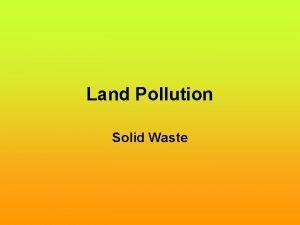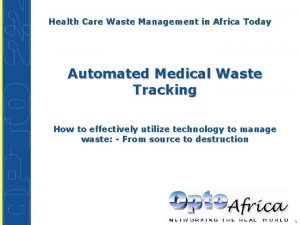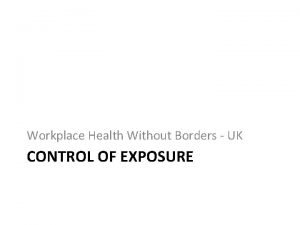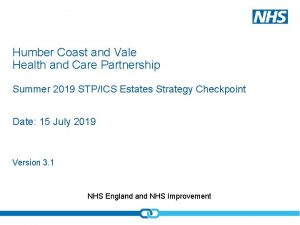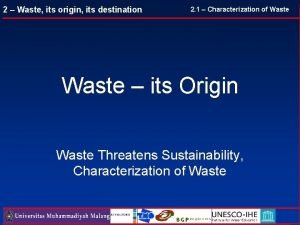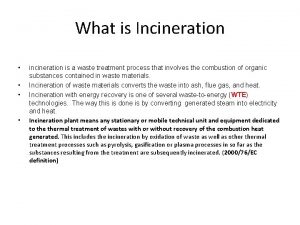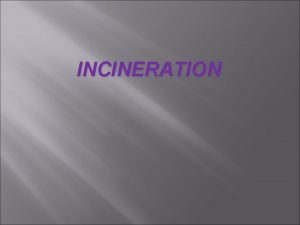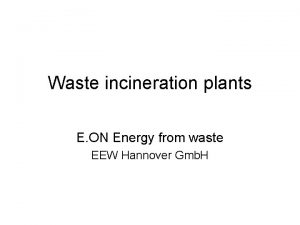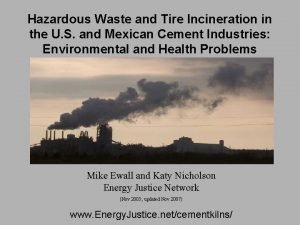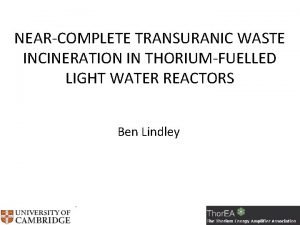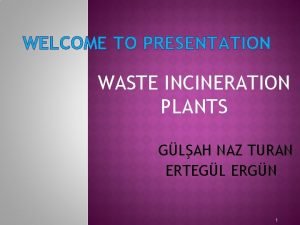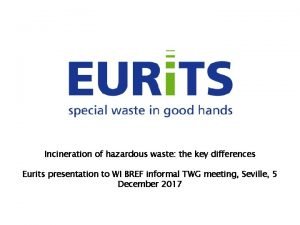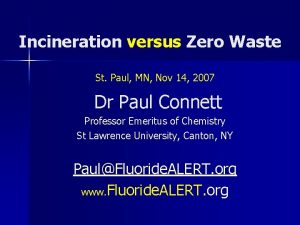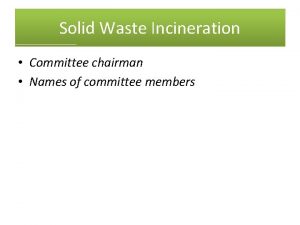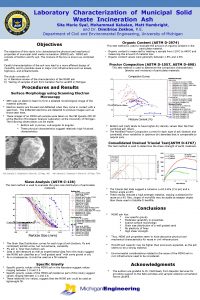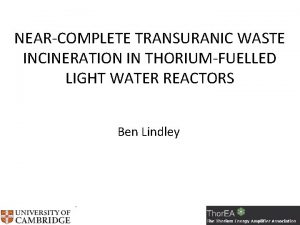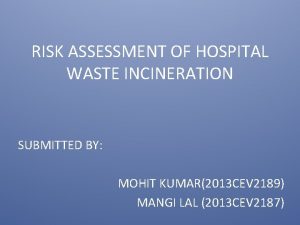Incineration and Health Care Waste Health Care Without

















- Slides: 17

Incineration and Health Care Waste Health Care Without Harm, 2004 1

Internationally there has been a move away from incineration n n This is true for America, India, Greece, Germany, France, Japan, Turkey, Netherlands, Costa Rica and the Philippines Incinerator companies are taking their technology East (Eastern Europe) and South Health Care Without Harm, 2004 2

Examples n Philippines, Clean Air Act (1999), Section 20 “Incineration, hereby defined as the burning of municipal, biomedical and hazardous waste, which process emits poisonous and toxic fumes is hereby prohibited” Health Care Without Harm, 2004 3

Rhode Island, USA (1992) – State Senate Act 92 -S 2502 “…incineration of solid waste is the most costly method of waste disposal with known and unknown escalating costs which would place substantial and unreasonable burdens on both state and municipal budgets to the point of seriously jeopardizing the public’s interest. ” n Health Care Without Harm, 2004 4

It is hazardous to the environment and is therefore not sustainable n n n Ash and atmospheric emissions Health problems – hormonal, immune and reproductive systems Audit of hospital waste streams conducted by ground. Work and Health Care Without Harm - 2001 Release of mercury a major concern Ash produced is much more poisonous than the waste before it is burnt Health Care Without Harm, 2004 5

n Air Quality Bill does not state WHAT particularly needs to be measured for!!! n Not enough reasonable measures n No timeframes Health Care Without Harm, 2004 6

Stockholm Convention n Incinerators seriously undermine the objectives of the POP’s treaty Stockholm Convention ratified by South Africa Incineration identified as principle source of dioxins and furans Health Care Without Harm, 2004 7

Environmental Protection Agency (1970’s) n § § The EPA describes it as: “one of the most, if not the most, potent reproductive/developmental toxicants known” Dioxins are classified as persistent organic pollutants (POPs) – once manufactured resist being broken down Bioaccumulation – up food chain Health Care Without Harm, 2004 8

n n Air Quality Bill does not deliver on Stockholm Convention Kwa. Zulu-Natal Department of Health does not have one incinerator that meets legal standards Civil society has lobbied government to implement non-thermal technologies Government taken to court by ground. Work over Ixopo incinerator Health Care Without Harm, 2004 9

n n Ixopo incinerator largest in KZN – poorly managed Audit reports showed failure to meet health and safety conditions of permit - exceeding emission levels prescribed - failure to meet required temperature (release of dioxins) Health Care Without Harm, 2004 10

n n April 2002, Civil Society Workshop on Health Care Waste and Incineration Formulation of Isipingo Declaration KZN government – policy decision to halt medical waste in province Two first ever non-thermal treatments were set up in KZN Health Care Without Harm, 2004 11

Air Quality Bill n n n Does not mention the phasing out of dirty technologies NO emphasis to the selection of clean production technologies No mention of emission control devices Inadequate guidance is given to officials entrusted with licensing of industries Air pollution control is about “technology forcing” Health Care Without Harm, 2004 12

Alternatives to incineration n Reduce, reuse, recycle – together with composting Numerous proposals on the table for incinerators; - Burning tyres (Pretoria Portlands Cement); - Wood, bark, sawdust, sludge (Mondi Paper) - Hazardous Waste (Natal Portlands Cement), etc. Halt production of substances that cannot be recycled Health Care Without Harm, 2004 13

n n n Waste reduction and separation is important Lessons from other countries such as the UK Recycling waste; e. g. tyres - rubber wheels - running tracks - surface materials for roads - backing of carpets and car mats Wood and bark – composting Sadly this Bill gives no empathies to pollution minimization Health Care Without Harm, 2004 14

Conclusion n Building incinerators is a reaction to the problem of waste management and is not part of a sustainable energy policy Burning matter does not destroy it. Burning it converts it into another form and redistributes it in the air, land water We need to move away from waste disposal to waste management Health Care Without Harm, 2004 15

n n n The Air Quality Bill needs to be strengthened through the following: It needs to commit to the phasing out of dirty technology such as incinerators. It also needs to give emphasis to the selection of clean production technologies that would emit few pollutants than burn technologies; Health Care Without Harm, 2004 16

n It also needs to emphasize emission control devices, i. e. scrubbers to reduce pollution levels (Section 36). Guidance needs to be given to authorities for decision making on licensing. Health Care Without Harm, 2004 17
 Food waste management system
Food waste management system Cons of incineration
Cons of incineration Disadvantages of incineration
Disadvantages of incineration Management of health care waste
Management of health care waste Learning without reflection is a waste meaning
Learning without reflection is a waste meaning Health and social care component 3 health and wellbeing
Health and social care component 3 health and wellbeing Without title poem
Without title poem The father in the poem without title
The father in the poem without title Without rush without engines poetic device
Without rush without engines poetic device Health and social care values unit 2
Health and social care values unit 2 Tertiary level of care
Tertiary level of care Workplace health without borders
Workplace health without borders West yorkshire and harrogate health and care partnership
West yorkshire and harrogate health and care partnership Humber coast and vale ics
Humber coast and vale ics An example of appraisal in health and social care
An example of appraisal in health and social care Verna and sam
Verna and sam Computer waste and mistakes
Computer waste and mistakes Waste and its types
Waste and its types

